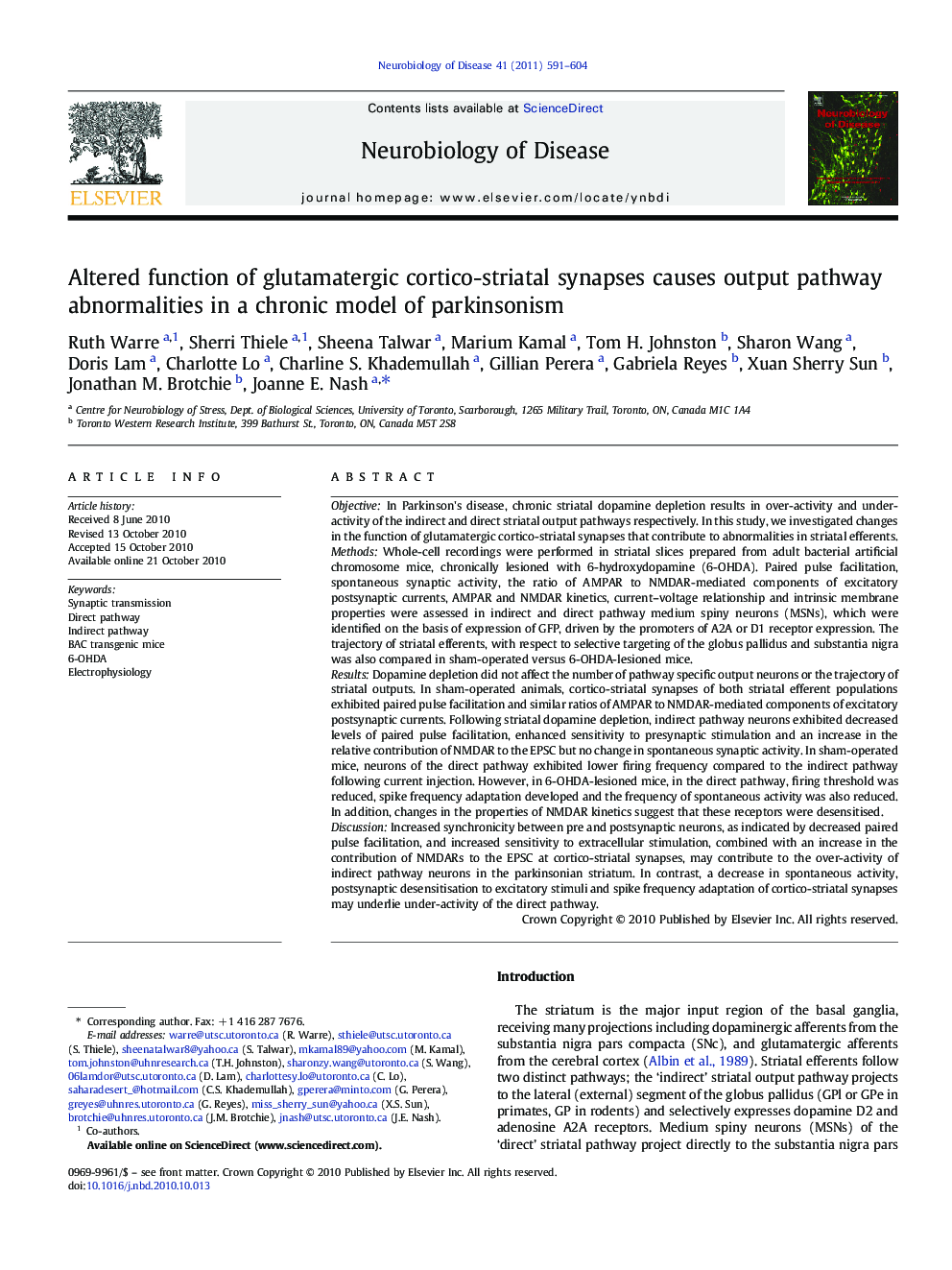| کد مقاله | کد نشریه | سال انتشار | مقاله انگلیسی | نسخه تمام متن |
|---|---|---|---|---|
| 3069749 | 1580697 | 2011 | 14 صفحه PDF | دانلود رایگان |

ObjectiveIn Parkinson's disease, chronic striatal dopamine depletion results in over-activity and under-activity of the indirect and direct striatal output pathways respectively. In this study, we investigated changes in the function of glutamatergic cortico-striatal synapses that contribute to abnormalities in striatal efferents.MethodsWhole-cell recordings were performed in striatal slices prepared from adult bacterial artificial chromosome mice, chronically lesioned with 6-hydroxydopamine (6-OHDA). Paired pulse facilitation, spontaneous synaptic activity, the ratio of AMPAR to NMDAR-mediated components of excitatory postsynaptic currents, AMPAR and NMDAR kinetics, current–voltage relationship and intrinsic membrane properties were assessed in indirect and direct pathway medium spiny neurons (MSNs), which were identified on the basis of expression of GFP, driven by the promoters of A2A or D1 receptor expression. The trajectory of striatal efferents, with respect to selective targeting of the globus pallidus and substantia nigra was also compared in sham-operated versus 6-OHDA-lesioned mice.ResultsDopamine depletion did not affect the number of pathway specific output neurons or the trajectory of striatal outputs. In sham-operated animals, cortico-striatal synapses of both striatal efferent populations exhibited paired pulse facilitation and similar ratios of AMPAR to NMDAR-mediated components of excitatory postsynaptic currents. Following striatal dopamine depletion, indirect pathway neurons exhibited decreased levels of paired pulse facilitation, enhanced sensitivity to presynaptic stimulation and an increase in the relative contribution of NMDAR to the EPSC but no change in spontaneous synaptic activity. In sham-operated mice, neurons of the direct pathway exhibited lower firing frequency compared to the indirect pathway following current injection. However, in 6-OHDA-lesioned mice, in the direct pathway, firing threshold was reduced, spike frequency adaptation developed and the frequency of spontaneous activity was also reduced. In addition, changes in the properties of NMDAR kinetics suggest that these receptors were desensitised.DiscussionIncreased synchronicity between pre and postsynaptic neurons, as indicated by decreased paired pulse facilitation, and increased sensitivity to extracellular stimulation, combined with an increase in the contribution of NMDARs to the EPSC at cortico-striatal synapses, may contribute to the over-activity of indirect pathway neurons in the parkinsonian striatum. In contrast, a decrease in spontaneous activity, postsynaptic desensitisation to excitatory stimuli and spike frequency adaptation of cortico-striatal synapses may underlie under-activity of the direct pathway.
Research Highlights
► Dopamine depletion differentially alters pathway specific cortico-striatal synapses
► On the indirect pathway PPR is decreased and sensitivity to stimulation increased.
► Spontaneous neurotransmitter release onto the direct pathway is decreased.
► Direct pathway neurons show NMDAR desensitisation and altered membrane properties.
► Synaptic changes in the direct and indirect pathways contribute to parkinsonism.
Journal: Neurobiology of Disease - Volume 41, Issue 3, March 2011, Pages 591–604